lexus LFA 2012 Owner's Manual / LEXUS 2012 LFA OWNERS MANUAL (OM77006U)
Manufacturer: LEXUS, Model Year: 2012, Model line: LFA, Model: Lexus LFA 2012Pages: 420, PDF Size: 5.02 MB
Page 351 of 420

5
When trouble arises
349
5-2. Steps to take in an emergency
Start the engine of the second vehicle. Increase the engine speed
slightly and maintain at that level for approximately 5 minutes to
recharge the battery of your vehicle.
Maintain the engine speed of th e second vehicle and start the
engine of your vehicle.
Once the vehicle’s engine has started, remove the jumper cables
in the exact reverse order from which they were connected.
After disconnecting the jumper cables, make sure that the negative (-)
battery terminal on your vehicle is fixed securely.
Once the engine starts, have the vehicle inspected at your Lexus dealer
as soon as possible.
■Starting the engine when the battery is discharged
●If the gear indicator is not displayed when an attempt is made to start the
engine, the engine is not yet ready to start. Depress the brake pedal for several
seconds and wait for the ge ar indicator to appear.
●The engine cannot be started by push-starting.
■To prevent battery discharge
●Turn off the headlights and the audio system while the engine is off.
●Turn off any unnecessary electrical compon ents when the vehicle is running at a
low speed for an extended period, such as in heavy traffic.
STEP3
STEP4
STEP5
Page 352 of 420

350
5-2. Steps to take in an emergency
CAUTION
■To prevent a vehicle fire
When connecting or disconnecting the jumper cables to or from the battery, make
sure that they are not in contact with any part made of CFRP (Carbon Fiber Rein-
forced Plastics). Failure to do so may cause a fire hazard.
■Avoiding battery fires or explosions
Observe the following precautions to prevent accidentally igniting the flammable
gas that may be emitted from the battery.
●Make sure each jumper cable is connecte d to the correct terminal and that it is
not unintentionally in contact with any part other than the intended terminal.
●Do not allow the + and - clamps of the jumper cables to come into contact with
each other.
●Do not smoke, use matches, cigarette lighters or allow open flame near the bat-
tery.
■Battery precautions
The battery contains poisonous and corrosive acidic electrolyte, while related parts
contain lead and lead compounds. Observe the following precautions when han-
dling the battery:
●When working with the battery, always we ar safety glasses and take care not to
allow any battery fluids (acid) to come into contact with skin, clothing or the vehi-
cle body.
●Do not lean over the battery.
●In the event that battery fluid comes into contact with the skin or eyes, immedi-
ately wash the affected area with water and seek medical attention.
Place a wet sponge or cloth over the affected area until medical attention can be
received.
●Always wash your hands after handling the battery support, terminals, and other
battery-related parts.
●Do not allow children near the battery.
Page 353 of 420
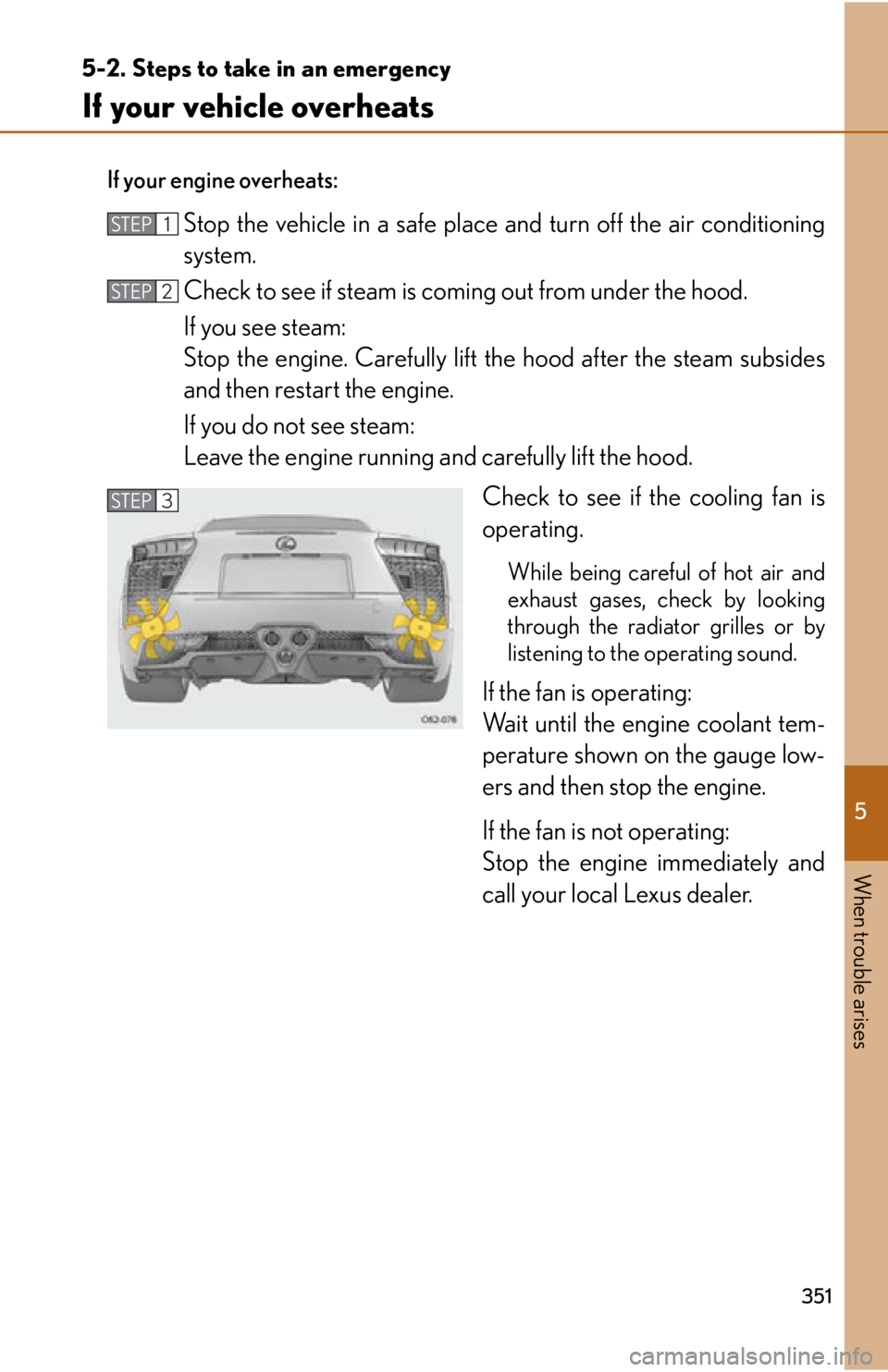
5
When trouble arises
351
5-2. Steps to take in an emergency
If your vehicle overheats
If your engine overheats:
Stop the vehicle in a safe place and turn off the air conditioning
system.
Check to see if steam is coming out from under the hood.
If you see steam:
Stop the engine. Care fully lift the hood after the steam subsides
and then restart the engine.
If you do not see steam:
Leave the engine running and carefully lift the hood.
Check to see if the cooling fan is
operating.
While being careful of hot air and
exhaust gases, check by looking
through the radiator grilles or by
listening to the operating sound.
If the fan is operating:
Wait until the engine coolant tem-
perature shown on the gauge low-
ers and then stop the engine.
If the fan is not operating:
Stop the engine immediately and
call your local Lexus dealer.
STEP1
STEP2
STEP3
Page 354 of 420
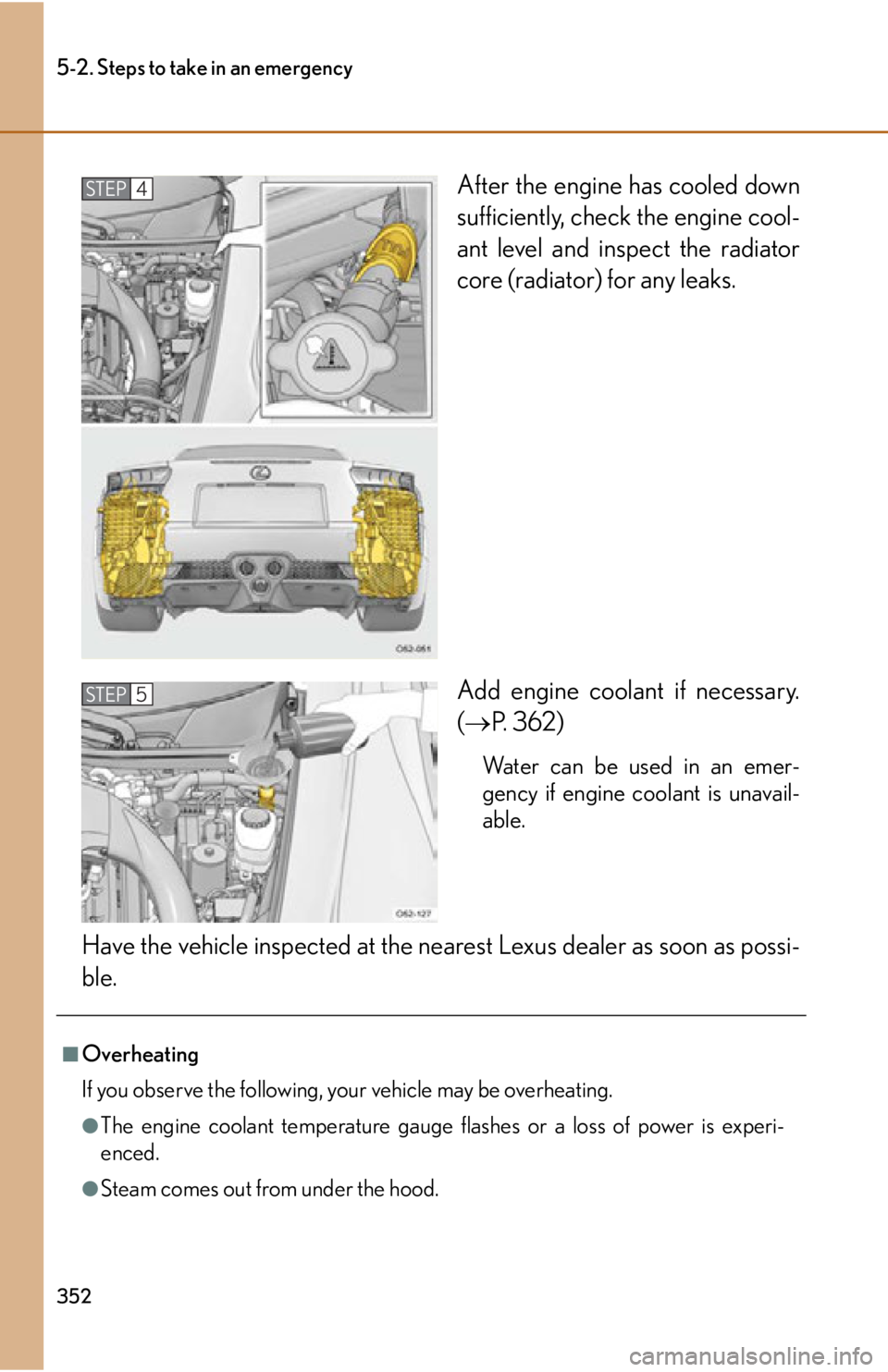
352
5-2. Steps to take in an emergency
After the engine has cooled down
sufficiently, check the engine cool-
ant level and inspect the radiator
core (radiator) for any leaks.
Add engine coolant if necessary.
(P. 362)
Water can be used in an emer-
gency if engine coolant is unavail-
able.
Have the vehicle inspected at the ne arest Lexus dealer as soon as possi-
ble.
STEP4
STEP5
■Overheating
If you observe the following, your vehicle may be overheating.
●The engine coolant temperature gauge flashes or a loss of power is experi-
enced.
●Steam comes out from under the hood.
Page 355 of 420
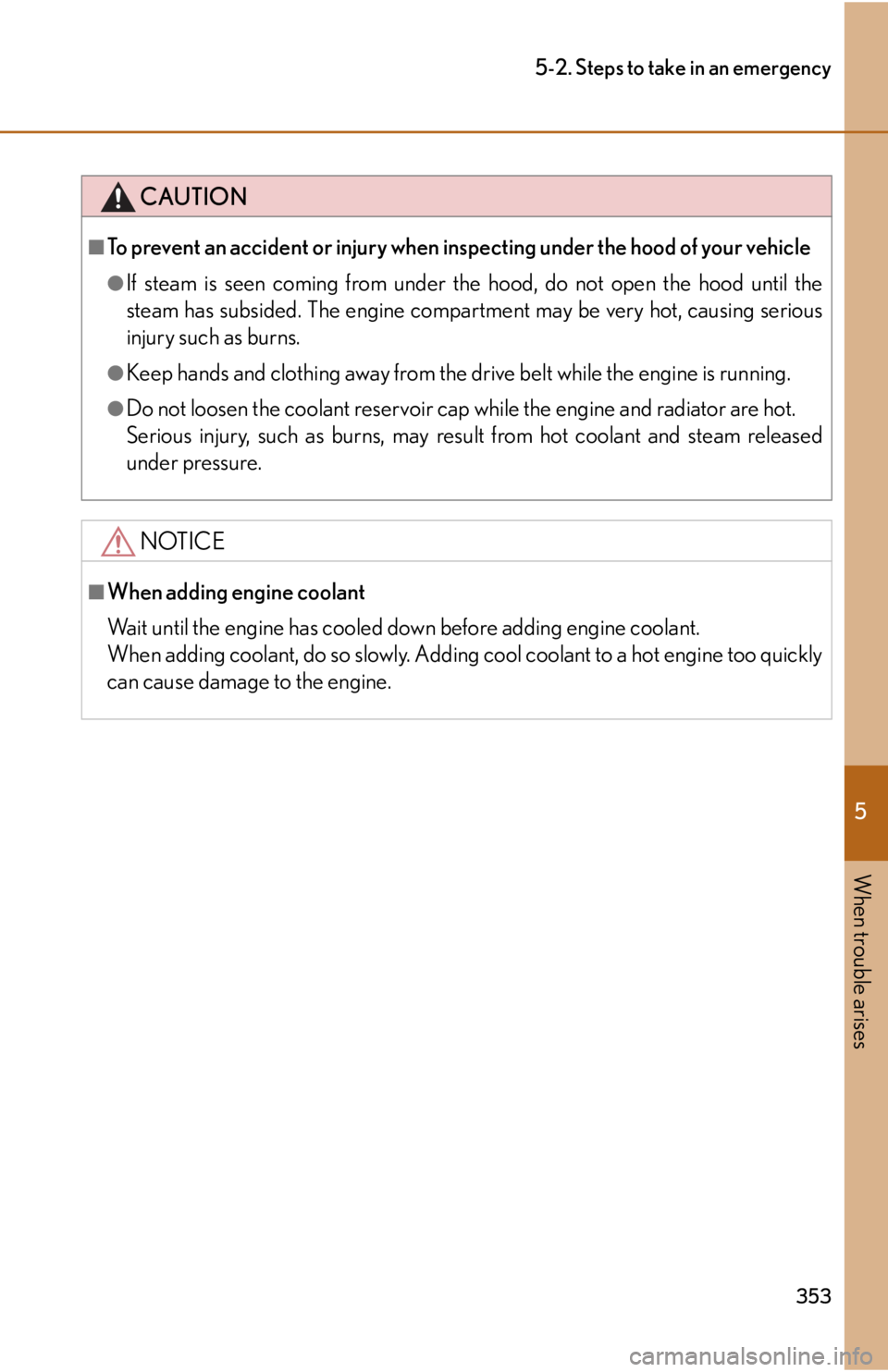
5
When trouble arises
353
5-2. Steps to take in an emergency
CAUTION
■To prevent an accident or injury when inspecting under the hood of your vehicle
●If steam is seen coming from under the hood, do not open the hood until the
steam has subsided. The engine compartm ent may be very hot, causing serious
injury such as burns.
●Keep hands and clothing away from the drive belt while the engine is running.
●Do not loosen the coolant reservoir cap while the engine and radiator are hot.
Serious injury, such as burns, may resu lt from hot coolant and steam released
under pressure.
NOTICE
■When adding engine coolant
Wait until the engine has cooled do wn before adding engine coolant.
When adding coolant, do so slowly. Adding cool coolant to a hot engine too quickly
can cause damage to the engine.
Page 356 of 420
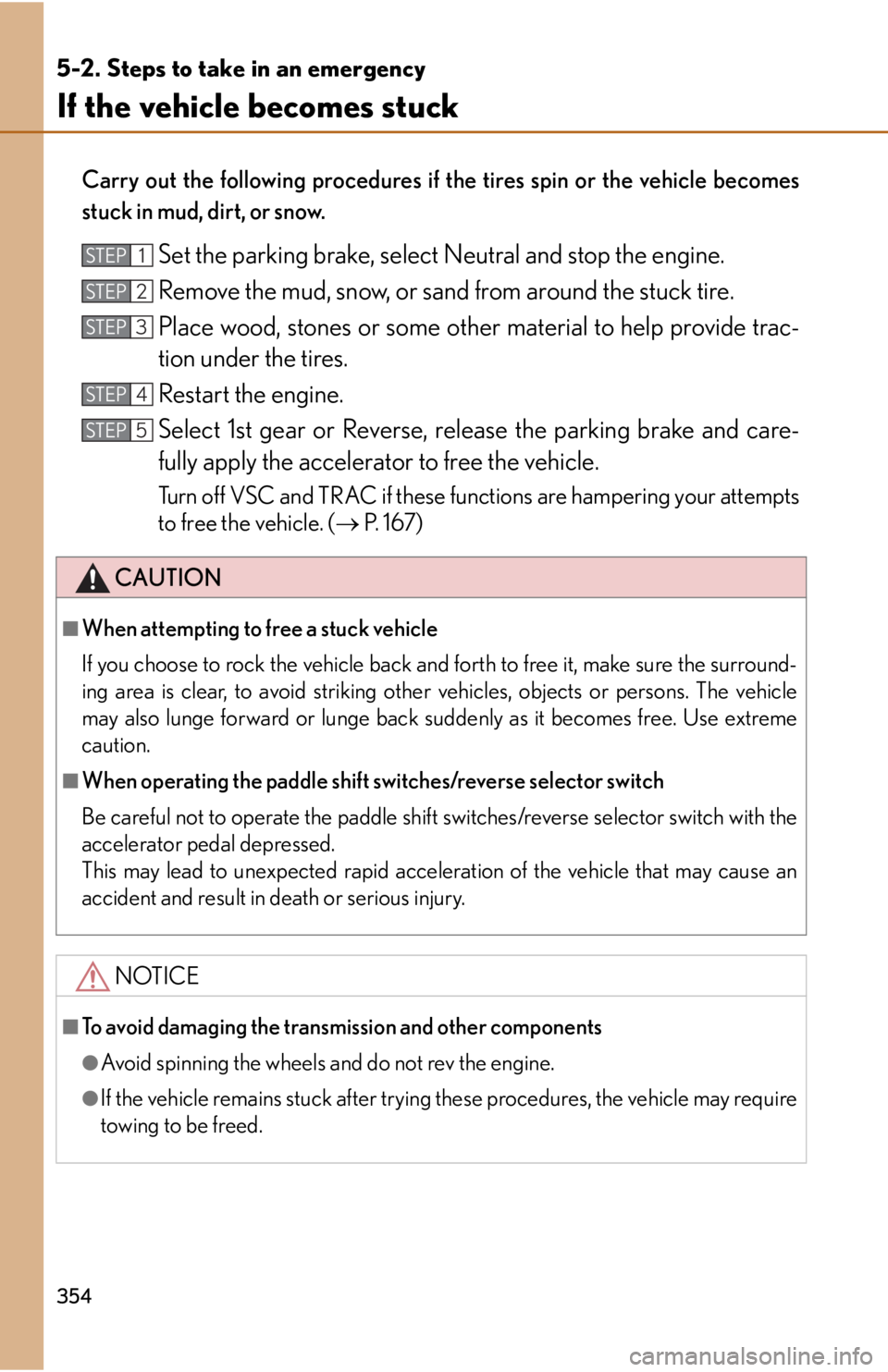
354
5-2. Steps to take in an emergency
If the vehicle becomes stuck
Carry out the following procedures if the tires spin or the vehicle becomes
stuck in mud, dirt, or snow.
Set the parking brake, select Neutral and stop the engine.
Remove the mud, snow, or sand from around the stuck tire.
Place wood, stones or some other material to help provide trac-
tion under the tires.
Restart the engine.
Select 1st gear or Reverse, release the parking brake and care-
fully apply the accelerator to free the vehicle.
Turn off VSC and TRAC if these functions are hampering your attempts
to free the vehicle. ( P. 1 6 7 )
CAUTION
■When attempting to free a stuck vehicle
If you choose to rock the vehicle back and forth to free it, make sure the surround-
ing area is clear, to avoid striking other vehicles, objects or persons. The vehicle
may also lunge forward or lunge back suddenly as it becomes free. Use extreme
caution.
■When operating the paddle shift switches/reverse selector switch
Be careful not to operate the paddle shift switches/reverse selector switch with the
accelerator pedal depressed.
This may lead to unexpected rapid acceleration of the vehicle that may cause an
accident and result in death or serious injury.
NOTICE
■To avoid damaging the transm ission and other components
●Avoid spinning the wheels and do not rev the engine.
●If the vehicle remains stuck after trying these procedures, the vehicle may require
towing to be freed.
STEP1
STEP2
STEP3
STEP4
STEP5
Page 357 of 420
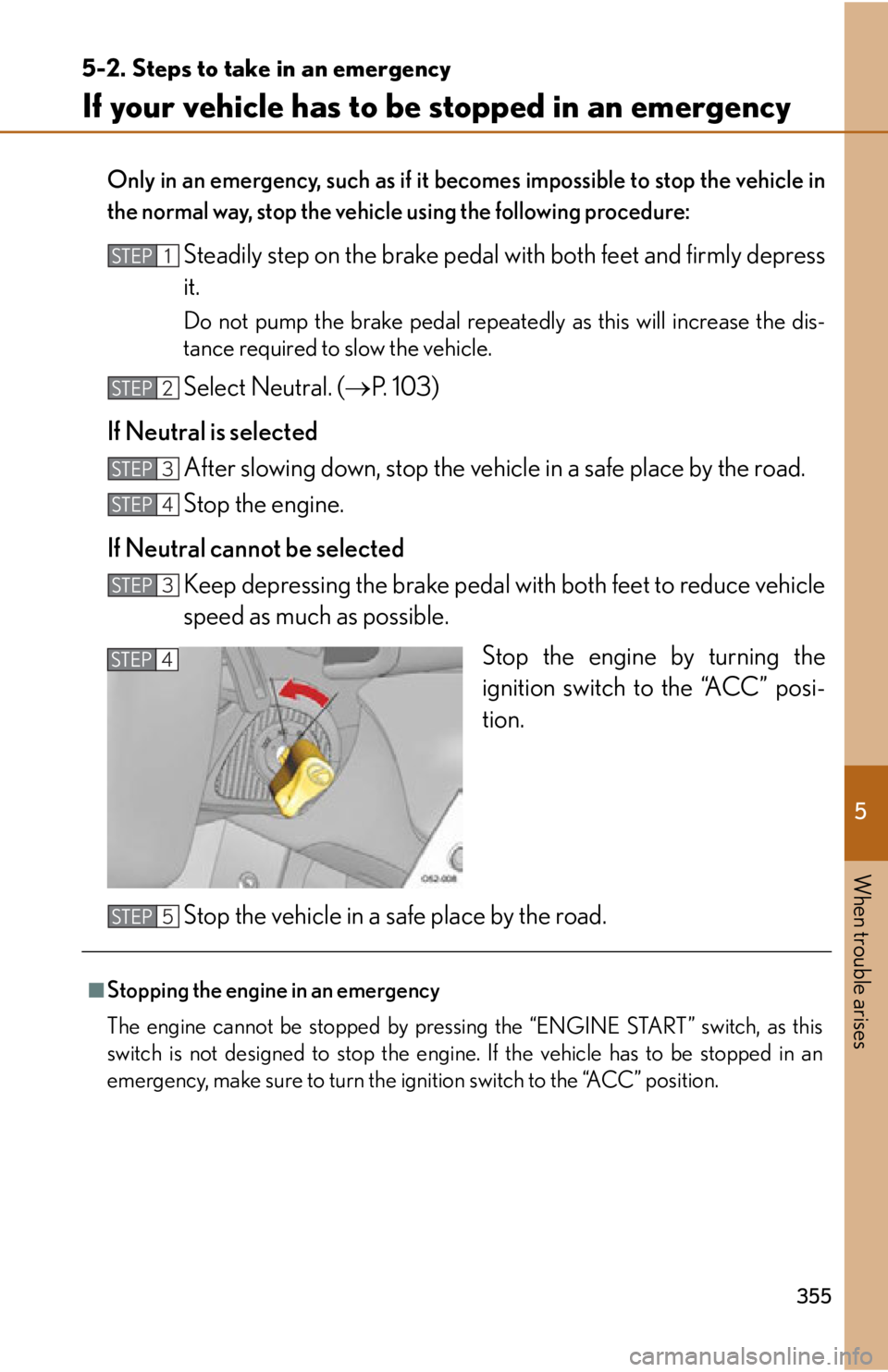
5
When trouble arises
355
5-2. Steps to take in an emergency
If your vehicle has to be stopped in an emergency
Only in an emergency, such as if it becomes impossible to stop the vehicle in
the normal way, stop the vehicle using the following procedure:
Steadily step on the brake pedal with both feet and firmly depress
it.
Do not pump the brake pedal repeatedly as this will increase the dis-
tance required to slow the vehicle.
Select Neutral. ( P. 103)
If Neutral is selected After slowing down, stop the vehicle in a safe place by the road.
Stop the engine.
If Neutral cannot be selected Keep depressing the brake pedal with both feet to reduce vehicle
speed as much as possible.
Stop the engine by turning the
ignition switch to the “ACC” posi-
tion.
Stop the vehicle in a safe place by the road.
STEP1
STEP2
STEP3
STEP4
STEP3
STEP4
■Stopping the engine in an emergency
The engine cannot be stopped by pressi ng the “ENGINE START” switch, as this
switch is not designed to stop the engine. If the vehicle has to be stopped in an
emergency, make sure to turn the ignition switch to the “ACC” position.
STEP5
Page 358 of 420

356
5-2. Steps to take in an emergency
CAUTION
■If the engine has to be turned off while driving
●If the engine is turned off, the power assist for the brakes and steering may not
function, making braking and steering more difficult. Decelerate as much as pos-
sible before turning off the engine.
●Never attempt to remove the key, as doing so will lock the steering wheel.
Page 359 of 420

Vehicle specifications6
357
6-1. SpecificationsMaintenance data (fuel, oil level, etc.) .............. 358
Fuel information ..................... 368
Tire information....................... 371
6-2. Customization Customizable features ........ 383
6-3. Initialization Items to initialize .................... 386
Page 360 of 420
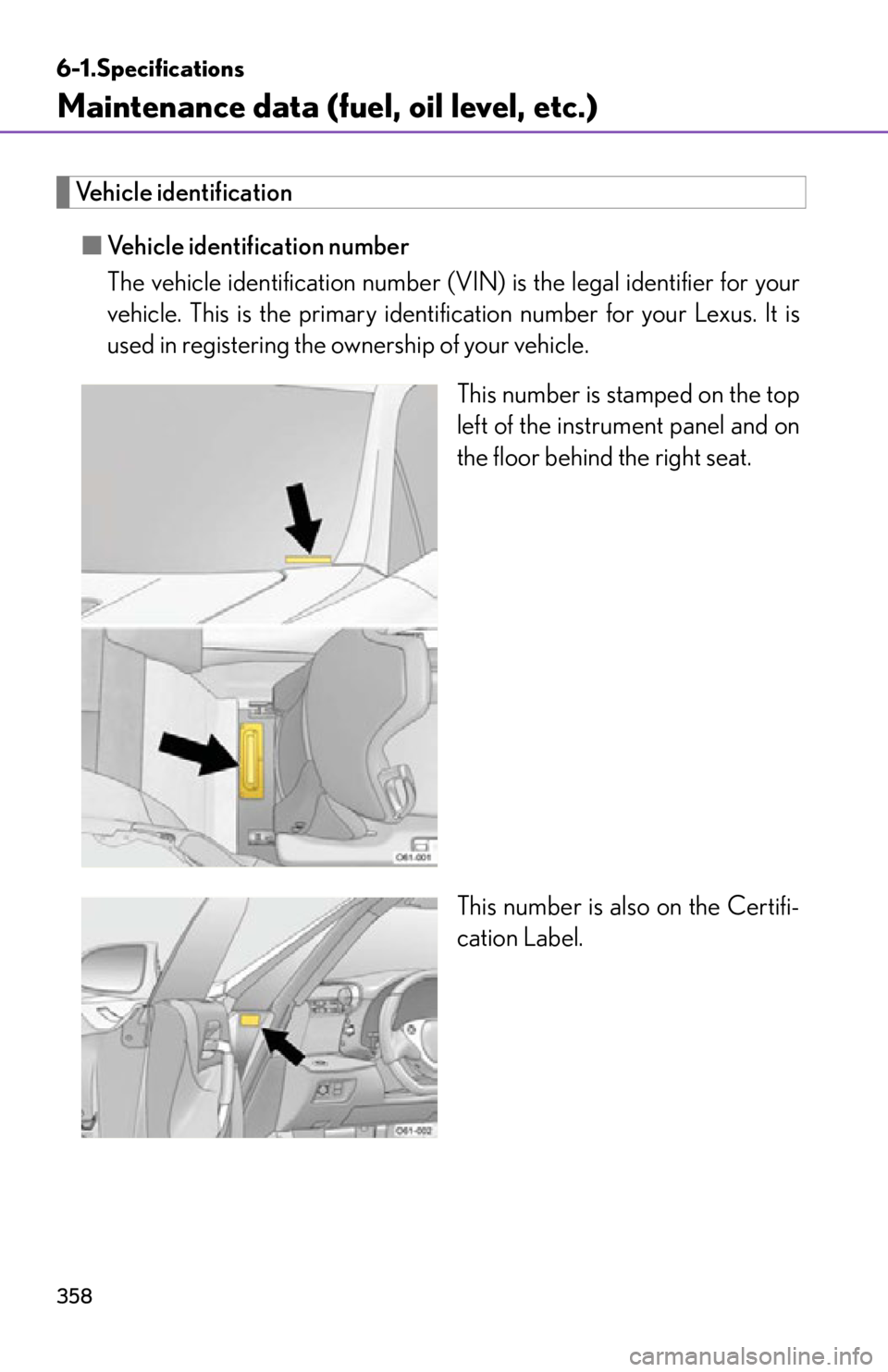
358
6-1.Specifications
Maintenance data (fuel, oil level, etc.)
Vehicle identification
■ Vehicle identification number
The vehicle identification number (V IN) is the legal identifier for your
vehicle. This is the primary identi fication number for your Lexus. It is
used in registering the ownership of your vehicle.
This number is stamped on the top
left of the instrument panel and on
the floor behind the right seat.
This number is also on the Certifi-
cation Label.